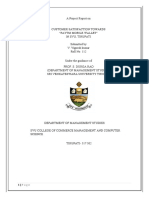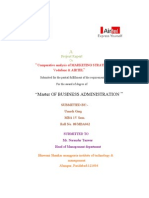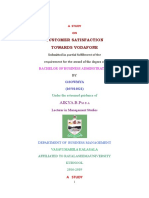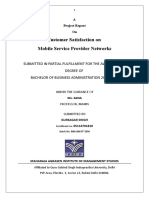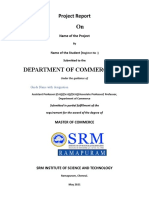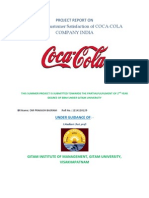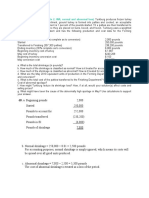Project On Consumer Satisfaction
Uploaded by
mahithaProject On Consumer Satisfaction
Uploaded by
mahithaA STUDY
ON
CUSTOMER SATISFACTION
TOWARDS VODAFONE
Submitted in partial fulfillment of the
requirement for the award of the degree of
BACHELOR OF BUSINESS ADMINSTRATION
BY
G.SOWMYA
(165014021)
Under the esteemed guidance of
AIKYA.B.PM.B.A
Lecturer in Management Studies
DEPARTMENT OF BUSINESS MANAGEMENT
VASAVI MAHILA KALASALA
AFFILIATED TO RAYALASEEMAUNIVERSITY
KURNOOL
2016-2019
A STUDY
ON
CUSTOMER SATISFACTION
TOWARDS VODAFONE
Submitted in partial fulfillment of the
requirement for the award of the degree of
BACHELOR OF BUSINESS ADMINSTRATION
BY
G.SOWMYA
(165014021)
Under the esteemed guidance of
AIKYA.B.PM.B.A
Lecturer in Management Studies
DEPARTMENT OF BUSINESS MANAGEMENT
VASAVI MAHILA KALASALA
AFFILIATED TO RAYALASEEMA UNIVERSITY
KURNOOL
2016-2019
Vasavi Mahila Kalasala
Kurnool
Department of Business Management
CERTIFICATE
This is to certify that the Project Report titled “A STUDY OF CUSTOMER
SATISFACTION TOWARDS VODAFONE” was carried out by
G.SOWMYA, of Regd.No:165014021. This is submitted in partial fulfillment for
the award of the Degree of Bachelor of Business Administration(BBA) of
Rayalaseema University ,during the academic year 2016- 2019.
EXAMINER PRINCIPAL HOD
PROJECT GUIDE CERTIFICATE
Ms.G.SOWMYA ,pursuing BBA of final year from Vasavi Mahila Kalasala, Kurnool in
partial fulfillment for the award of the degree has done her project entitled, “A STUDY
ON CUSTOMER SATISFACTION TOWARDS VODAFONE”, under my guidance
has furnished the details true to the possible extent of my knowledge.
Place:
Date:
Aikya.B.P
Lecturer of the Department
of Management Studies
DECLARATION
I hereby declare that this Project Report titled “A
study on customer satisfaction towards vodafone”
submitted by me to the Department of Business
Management, Vasavi Mahila Kalasala, is a bonafide
work undertaken by me and it is not submitted to any
other University or Institution for the award of any
degree/diploma/certificate or published any time
before.
Name of the Student Signature of the Student
Date:
ACKNOWLEDGEMENT
I, the researcher would like to express my thanks to all those who helped me
directly or indirectly to complete this project.
First, I take this opportunity to express my sincere thanks to our
Principal Smt. Dr. N. Parvathi Madam and the college management for
providing an opportunity and facility in successful completion of my project.
I also thank Akiya B.P Mam, Vasavi Mahila Kalasala, Kurnool for his constant
guidance and valuable advice.
My heartful thanks to the N.Sandeep Kumar sir ,N.Purnima Devi Mam
P .keerthi kumari Mam, G.S.Radha Mam, K.Vinod Kumar Sir, who
showed infinite interest and helped me at all times with valuable suggestions and
kind co-operation without whom I could not draw multifarious sketch for my
Project Work.
Finally, I am thankful to my parents who helped me directly in my phase of
completion of this project work.
G.SOWMYA
contents
1. Introduction 8
2. Industry Profile 11
3. Company Profile 14
4. Need for the Study 22
5. Research Methodology 24
6. Concepts of Retailing 28
7. Data Analysis 33
8. Findings 44
9. Annexure
Questionnaire 46
Bibliography 50
MARKETING
Goods and services do not move automatically from
producers to the users. There is a definite mechanism that brings about
exchange of goods and services against money. Marketing is the belt
that connects two major wheels of any economy namely producers and
consumers. It is the creation of utilities as goods and services get value
addition by the time they reach the consumers.
“ Marketing is the social process in which individuals and
organizations obtain what they need and want they through creating and
exchanging value with others.’’
MANAGEMENT
Vodafone group plc/Vodafone/is a British multinational
telecommunications conglomerate, with headquarters in London. …
Its Vodafone Global Enterprise division provides telecommunications
and IT services to corporate clients in 150 countries.
….Kotler and Amstrong
What is a 'Customer'
A customer is an individual or business that purchases the goods or services
produced by a business. Attracting customers is the primary goal of most public-
facing businesses, because it is the customer who creates demand for goods and
services. The word customer historically derives from “custom”, meaning ”habit”,
a customer was someone who frequented a particular shop, who made it a habit to
purchase goods there, and with whom the shopkeeper had to maintain a
relationship to keep his or her “custom”, meaning expected purchases in the future.
CUSTOMER SATISFACTION
Customer satisfaction, a business term is a measure of how products and services
supplied by a company meet or surpass customer expectation. It is seen as a key
performance indicator within business and is part of the four of a balanced
scorecard.
Customer satisfaction provides a leading indicator of consumer purchase intentions
and loyalty. Customer satisfaction data are among the most frequently collected
indicators of market perceptions. Their principal use is twofold.
Customer satisfaction is the most common form of market research in business-to-
business markets and is often connected to quality and production measurement,
rather than as straight marketing based research. Before setting up a customer
satisfaction programmed, it is necessary to ensure that the organization has the will
to actually make changes for improvement; otherwise you will simply be annoying
customers by taking their time to collect information, then not doing anything with
it.
Customer satisfaction refers to the emotional response that people feel after
making a purchase from a company. The more positive the level of customer
satisfaction, the more likely the purchaser is to come back and buy again and to
recommend that company to others who are looking for what the seller has to offer.
Word of mouth and referrals are often the most promising ways for a business to
grow.
DEFINITION:
“Satisfaction is a person’s feelings of pressure of disappointment resulting from
comparing a products perceived performance in relation to his or her
expectations.”
Philip Kotler
INDUSTRY PROFILE
Telecommunications is the backbone of our future economy. International
competitiveness increasingly depends on the development of a telecommunications
infrastructure that is compatible with internationalstandards"
The cellular industry all over the world has been witnessing very high growth rates
in subscriber base in recent years. For developing countries in particular, cellular
services are becoming a very significant proportion of the overall telecom
infrastructure. The mechanics of competition within this market involve complex
feedback effects between individual service providers and with their operating
environment, and these forces play an important role in governing the growth of
this industry.
The Indian telecommunications sector has undergone a major process of
transformation because of significant Government policy reforms during the recent
years. The New Telecom Policy, 1999 focused on creating an ideal environment
for investment, establishing communication infrastructure by leveraging on
technological development and providing affordable telecom services to all.We
believe that with these major initiatives of the Government, the mobile market in
India will have a promising future.
In a country like India which is not yet telephone-saturated and the ongoing
changes in related areas are resulting in a rapidly changing profile of users,
providers and their respective needs, continuous revision of the telecom policy is
imperative. Given the emerging new technologies and the integrating economies
there must be fairness among competitors.
The tele-density in India is about four per hundred people in respect of the fixed
telephones and a little less than one in respect of the mobile telephony. The
densities are not because there is no need for a telephone but because of its high
cost that many cannot afford that one. The situation here is nothing but holding
true of the “law of demand”.
You can now directly access your email account on Yahoo! Mail on your
Vodafone phone. What’s more, you do not need a WAP enabled handset for this
service as it is based on SMS. So gain freedom from your PC and access your
Yahoo! mails anytime, anywhere on your Vodafone phone. You will be charged
Rs. 2 per outgoing message. Incoming messages are free.
Party invitations, movie outings, festive greetings whatever be the occasion, you
can send your message to all your friends at one go!
With Group Messaging from Vodafone, you can thus save yourself the bother of
painstakingly sending your message to one person at a time whether you are on
Vodafone Prepaid or Postpaid.
Vodafone4help now lets you take advantage of a lot more services than before.
You can connect to the nearest fire brigade or mechanic or florist or even order a
pizza. If you are stranded in the middle of the road, or if you you need immediate
medical attention or if you are looking for a police station close by, Vodafone4help
gives you instant access to your nearest source of help, anywhere in Delhi or the
NCR.All the help services are [email protected]/min. while for police and fire help
only local airtime charge is applicable.
COMPETITORS OF VODAFONE
• RELIANCE INDUSTRIES LIMITED
• BHARAT SACHAR NIGAM LIMITED
• BHARTI AIRTEL LIMITED
Vodafone is a mobile network operator headquartered in Berkshire, England, UK.
It is the largest mobile telecommunications network company in the world by
turnover and has a market value of about £75 billion (August 2013). Vodafone
currently has operations in 25 countries and partner networks in a further 42
countries.
The name Vodafone comes from Voice data fone, chosen by the company to
"reflect the provision of voice and data services over mobile phones."
As of 2013 Vodafone had an estimated 260 million customers in 25 markets across
5 continents. On this measure, it is the second largest mobile telecom group in the
world behind China Mobile.
In the United States, Vodafone owns 45% of Verizon
Vodafone is primarily a user of technology rather than a developer of it, and this
fact is reflected in the emphasis of our work program on enabling new applications
of mobile communications, using new technology for new services, research for
improving operational efficiency and quality of our networks, and providing
technology vision and leadership that can contribute directly to business decisions.
In February 2004 Vodafone signed a Partner Network Agreement with
Luxembourg's LuxGSM and a Partner Network Agreement with Cyta of Cyprus.
Cyta agreed to rename its mobile phone operations to Cytamobile-Vodafone. In
April 2004 the Company purchased Singlepoint airtime provider from John
Caudwell (Caudwell Group) and approx 1.5million customers onto its base for
£405million, adding sites in Stoke on Trent (England) to existing sites in Newbury
(HQ), Birmingham, Warrington and Banbury. In November 2004 Vodafone
introduced 3G services into Europe.
In June 2005 the Company increased its participation in Romania's Connex to 99%
and also bought the Czech mobile operator Oskar. On 1 July 2005 Oskar of the
Czech Republic was rebranded as Oskar-Vodafone. Later that year on 17 October
2005 Vodafone Portugal launched a revised logo, using new text designed by
Dalton Maag, and a 3D version of the Speech mark logo, but still retaining a red
background and white writing (or vice versa). Also, various operating companies
started to drop the use of the SIM card pattern in the company logo. (The
rebranding of Oskar-Vodafone and Connex-Vodafone also does not use the SIM
card pattern.) A custom typeface by Dalton Maag (based on their font family
InterFace) formed part of the new identity.
On 28 October 2005 Connex in Romania was rebranded as Connex-Vodafone and
on 31 October 2005 the Company reached an agreement to sell Vodafone Sweden
to Telenor for approximately €1 billion. After the sale, Vodafone Sweden became
a Partner Network. In December 2005 Vodafone won an auction to buy Turkey's
second-largest mobile phone company, Telsim, for $4.5 billion. In December 2005
Vodafone Spain became the second member of the group to adopt the revised logo:
it was phased in over the following six months in other countries.
In 2006 the Company rebranded its Stoke-on-Trent site as Stoke Premier Centre, a
centre of expertise for the company dealing with Customer Care for its higher
value customers, technical support, sales and credit control. All cancellations and
upgrades started to be dealt with by this call centre. On 5 January 2006 Vodafone
announced the completion of the sale of Vodafone Sweden to Telenor. On
February 2006 the Company closed its Birmingham Call Centre. In 1 February
2006 Oskar Vodafone became
Vodafone Czech Republic, adopting the revised logo and on 22 February 2006 the
Company announced that it was extending its footprint to Bulgaria with the signing
of Partner Network Agreement with Mobiltel, which is part of mobilkom Austria
group.
On 12 March 2006 former chief, Sir Christopher Gent, who was appointed the
honorary post Chairman for Life in 2003, quits following rumours of boardroom
rifts. In April 2006 the Company announced that it has signed an extension to its
Partner Network Agreement with BITE Group, enabling its Latvian subsidiary
"BITE Latvija" to become the latest member of Vodafone's global partner
community. Also in April 2006 Vodafone Sweden changed its name to Telenor
Sverige AB and Connex-Vodafone became Vodafone Romania, also adopting the
new logo. On 30 May 2006 Vodafone announced the biggest loss in British
corporate history (£14.9 billion) and plans to cut 400 jobs; it reported one-off costs
of £23.5 billion due to the revaluation of its Mannesmann subsidiary. On 24 July
2006 the respected head of Vodafone Europe, Bill Morrow, quit unexpectedly and
on 25 August 2006 the Company announced the sale of its 25% stake in Belgium's
Proximus for €2 billion. After the deal, Proximus was still part of the community
as a Partner Network. Vodafone Iceland and on 19 December 2006 the Company
announced the sale of its 25% stake in Switzerland's Swisscom for CHF4.25 billion
(£1.8 billion). After the deal, Swisscom would still be part of the community as a
Partner Network. Finally in December 2006 the Company completed the
acquisition of Aspective, an enterprise applications systems integrator in the UK,
signaling Vodafone's intent to grow a significant presence and revenues in the ICT
marketplace.
Early in January 2007 Telsim in Turkey adopted Vodafone dual branding as
Telsim Vodafone and on 1 April 2007 Telsim Vodafone Turkey dropped its
original brand and became Vodafone Turkey. On 1 May 2007 Vodafone added
Jersey and Guernsey to the community, as Airtel was signed as Partner Network in
both crown dependencies. In June 2007 the Vodafone live! Mobile Internet portal
in the UK was relaunched. Front page was now charged for and previously
"bundled" data allowance was removed from existing contract terms. All users
were given access to the "full" web rather than a Walled Garden and Vodafone
became the first mobile network to focus an entire media campaign on its newly
launched mobile Internet portal in the UK. On 1 August 2007 Vodafone Portugal
launched Vodafone Messenger, a service with Windows Live Messenger and
Yahoo! Messenage
JIO PLANS AFTER JIO LAUNCH
Soon after Reliance Jio and Airtel started the tariff war, Vodafone joined
in. It launched the Rs. 352 recharge pack that offered 1GB data per day
for 56 days, or two recharge cycles of 28 days. Known as the Vodafone
Super Offer pack, it additionally provided unlimited local and STD calls
for the same validity period.
While the aforementioned pack was for prepaid users, Vodafone offered
free data to its RED postpaid users in April this year. The company was
offering either 3GB data per month for 12 months (totalling to 36GB) or
9GB data every month for duration of three months (totalling to 27GB).
In a bid to attract existing customers to its SuperNet 4G network,
Vodafone in April announced that customers in Mumbai could avail 4GB
of 4G data on 4G handsets on upgrading to a 4G SIM card on a 4G
handset. It was a one-time offer available for existing Vodafone
subscribers after they upgrade across Mumbai. While Vodafone prepaid
customers could avail this one-time offer with 4G free data for a period of
10 days, postpaid customers were to receive same 4GB data benefit till
the next billing date of their connection.
Vodafone soon started focusing on low validity recharge packs as rivals
were busy with data and calling packs with more validity. In May this
year, Vodafone announced a Rs. 19 recharge pack that offered one day
of validity with 100MB of 4G data and unlimited local and STD calls to
Vodafone network only. While celebrating the SuperWeek, Vodafone
also launched Rs. 49 and Rs. 89 recharge plans that offered seven days
of validity with 250MB of 4G data and unlimited local and STD calls to
just Vodafone customers and 250MB of 4G data with same validity, but
calls on other networks for free 100 minutes, in addition to unlimited
Vodafone local and STD calls, in a respective manner.
After a couple of data and calling plans, Vodafone came back in
Junewith a new recharge plan to mark the occasion of Ramzan in June.
However, it was only confined to the northern circles of Uttar Pradesh
West and Uttarakhand. With Ramzan Special Pack, 2G and 3G
customers could enjoy the unlimited data offer for Rs 5. and Rs. 19,
respectively. 2G customers could get unlimited local and STD calls plus
unlimited data for Rs. 253. Under the offer, customers also got unlimited
local and STD calls plus 1GB data per day for Rs. 345.
Later, the company came up with Rs. 786 recharge pack called the
'Vodafone Ramzan 786 Plan' with benefits varying with different telecom
circles. For Assam and North-East circle, the pack offered unlimited
voice calling, unlimited national roaming, and 25GB data at Rs. 786 for
postpaid users. On the other hand, prepaid subscribers from Rajasthan
were offered full talk time and ISD calling to UAE, Kuwait, Bahrain,
Qatar, and Saudi Arabia at just Rs. 0.14 per second also at Rs. 786
under the same plan rebranded as 'Vodafone Holy Ramzan Pack'. In
addition to this, Rajasthan users were also offered 'Vodafone FRC 445'
with unlimited local and national calls, plus 1GB 4G/3G data daily, with a
70 days validity period. Alternately, 'Vodafone FRC 295' provided
unlimited Vodafone to Vodafone calls along with 1GB 4G/3G data per
day for 70 days.
In June, Vodafone launched the Rs. 29 recharge pack, meant only for
data usage in the night between 1am to 6am, that offered unlimited
Internet 3G/ 4G data to the users. The company claimed that it roughly
translates to Rs. 6 per hour for unlimited Internet to its users for the
mentioned timings.
Lastly, Vodafone launched a new offerto include a free Netflix
membership for its postpaid users who have subscribed to Vodafone
RED plans worth Rs. 1,299 or higher. Depending on the subscription,
the validity of the free Netflix membership varies, giving the postpaid
users up to one year of the subscription. Additionally, postpaid users get
30GB of free data under the RED 1299 unlimited plan.
Presently, the Vodafone recharge plans listed on the company's website
include the Rs. 149 plan and Rs. 349 plan. The Rs. 149 plan offers
unlimited local and STD Vodafone calls along with 2GB data (for 4G
handset & 4G SIM), 300MB data (only 4G handset), and 50MB data
(non-4G handset) for 28 days. The Rs. 349 plan provides unlimited local
and STD calls on all networks and landlines along with 50MB of 3G/4G
data for 28 days. Customers with 4G handsets will get 1GB data
additionally.
The Vodafone plans released recently are targetting new 4G
subscribers, and do not offer the same benefits to the company's
existing customers. First up is the Rs. 244 Vodafone recharge that
provides 1GB data per day and bundled calls (both local and STD, on
Vodafone network only) for 70 days. However, the 70-day validity is only
for the first time you buy the recharge pack, and you will get only 35-day
validity the second time you purchase the Rs. 244 pack. For existing
Vodafone customers upgrading to 4G, there's the Rs. 346 plan, which
comes with 1GB data per day, bundled calls to any network (300 free
minutes per day, 1,200 per week) with 56-day validity.
For students joining its 4G network, the company has the 'Campus
Survival Kit', priced at Rs. 352. It comes with 1GB of data per day for 84
days, as well as discount coupons and a free messenger bag. However,
there's a catch - you need to purchase the Rs. 445 recharge for the first
84-day period, and only after that the recharge value will go down to Rs.
352.
In Rajasthan circle, Vodafone launched the Rs. 348 prepaid packwith
1GB data per day and unlimited local and STD calls. However, the
validity of this plan is just 28 days, a third of the competing Jio recharge
plan. Then there was the new Rs. 392 Vodafone pack that offers 1GB
data per day and unlimited STD and local calls for 28 days, a revised
version of the Rs. 346 pack.
For those who travel frequently, Vodafone launched a new unlimited
calling and data plan at as low as Rs. 180 per day. This plan is
applicable in popular destinations of Europe, such as the UK, Germany,
Spain, Italy, the Netherlands, Turkey, Greece, Portugal, Czech Republic,
Romania, and Hungary. The plans is available at different price points on
offer, and user can choose between plans based on validities, from Rs.
500 for 24 hours to Rs. 5,000 for 28 days
NEED FOR THE STUDY:
Following are the main objective to study about the customer satisfaction on
Vodafone.
• To study telecommunication industry.
• To study the company profile of Vodafone.
• To study customer satisfaction of Vodafone.
• To study various Marketing activities provided by Vodafone.
• To study the various services provided by Vodafone.
RESEARCH METHODOLOGY
“Marketing research means the systematic gathering, recording, analyzing of
data about problems relating to the marketing of goods and services”
METHODOLOGY ADOPTED:
Research methodology is a way to systematically solve the research problem. Here
we study the various steps generally adopted by the researcher in studying the
research methods to continue a part of research methodology.
In this research, both Primary and Secondary data taken into consideration. The
project would be executed through primary data i.e. questionnaires, discussion with
various age groups of employee, information from other group of companies,
internet data’s.
Primary data: - This is those, which are collected as fresh and for the first
Time, and thus happen to be original in character. There are many ways of
data collection of primary data like questionnaire, observation method,
interview method, through schedules, pantry Reports, distributors audit,
consumer panel etc.
Secondary data: - These are those data, which are not collected afresh and
are used earlier also and thus they cannot be considered as original in
character. There are many ways of data collection of secondary data like
publications of the state and central govt., website, journals, companies
reports, reports prepared by researchers, reports of various associations
connected with business, Industries, banks etc. For this project secondary
data was taken from company’s reports and websites.
RESEARCH DESIGN:
• Type of research: Descriptive research design
• Sources of data: Primary Data & Secondary Data
• Primary Data – Questionnaire
• Secondary Data – Websites
• Data collection method: Survey Method,Questionaire
• Survey Instrument: Questionnaire (Closed and Open Ended)
• Method of communication: Collect the data through survey of
the employees in the organization
• Sample size: 100 respondents
• Sample unit: Here the researcher has randomly selected the
respondents of the kurnool
• Sampling Design: Convenient sampling (sample collection)
LIMITATION OF STUDY
• A number of customers are not satisfied with services, new schemes and
offers.
• A number of customers are not satisfied with the network coverage.
• A number of customers are not satisfied with the current call rates of
Vodafone.
• A number of customers are not satisfied with the Free SMS schemes.
• A number of customers are not satisfied with the service of customer care of
Vodafone.
INTRODUCTION:
Customer satisfaction, a business term, is a measure of how products and services
supplied by a company meet or surpass customer expectation. It is seen as a key
performance indicator within business and is part of the four perspectives of a
Balanced Scorecard.
In a competitive marketplace where businesses compete for customers, customer
satisfaction is seen as a key differentiator and increasingly has become a key
element of business strategy.
There is a substantial body of empirical literature that establishes the benefits of
customer satisfaction for firms.
MEASURINGCUSTOMERSATISFACTION
Organizations are increasingly interested in retaining existing customers while
targeting non-customers; measuring customer satisfaction provides an indication of
how successful the organization is at providing products and/or services to the
marketplace.
Customer satisfaction is an ambiguous and abstract concept and the actual
manifestation of the state of satisfaction will vary from person to person and
product/service to product/service. The state of satisfaction depends on a number
of both psychological and physical variables which correlate with satisfaction
behaviors such as return and recommend rate. The level of satisfaction can also
vary depending on other options the customer may have and other products against
which the customer can compare the organization's products.
Because satisfaction is basically a psychological state, care should be taken in the
effort of quantitative measurement, although a large quantity of research in this
area has recently been developed. Work done by Berry, Brodeur between 1990 and
1998 defined ten 'Quality Values' which influence satisfaction behavior, further
expanded by Berry in 2002 and known as the ten domains of satisfaction. These
ten domains of satisfaction include: Quality, Value, Timeliness, Efficiency, Ease of
Access, Environment, Inter-departmental Teamwork, Front line Service Behaviors,
Commitment to the Customer and Innovation. These factors are emphasized for
continuous improvement and organizational change measurement and are most
often utilized to develop the architecture for satisfaction measurement as an
integrated model. Work done by Parasuraman, Zeithaml and Berry between 1985
and 1988 provides the basis for the measurement of customer satisfaction with a
service by using the gap between the customer's expectation of performance and
their perceived experience of performance. This provides the measurer with a
satisfaction "gap" which is objective and quantitative in nature. Work done by
Cronin and Taylor propose the "confirmation/disconfirmation" theory of
combining the "gap" described by Parasuraman, Zeithaml and Berry as two
different measures (perception and expectation of performance) into a single
measurement of performance according to expectation. According to Garbrand,
customer satisfaction equals perception of performance divided by expectation of
performance.
The usual measures of customer satisfaction involve a survey with a set of
statements using a Likert Technique or scale. The customer is asked to evaluate
each statement and in term of their perception and expectation of performance of
the organization being measured.
Customer satisfaction, a business term is a measure of how products and services
supplied by a company meet or surpass customer expectation. It is seen as a key
performance indicator within business and is part of the four of a balanced
scorecard.
Customer satisfaction provides a leading indicator of consumer purchase intentions
and loyalty. Customer satisfaction data are among the most frequently collected
indicators of market perceptions. Their principal use is twofold.
Customer satisfaction is the most common form of market research in business-to-
business markets and is often connected to quality and production measurement,
rather than as straight marketing based research. Before setting up a customer
satisfaction programmed, it is necessary to ensure that the organization has the will
to actually make changes for improvement; otherwise you will simply be annoying
customers by taking their time to collect information, then not doing anything with
it.
Customer satisfaction refers to the emotional response that people feel after
making a purchase from a company. The more positive the level of customer
satisfaction, the more likely the purchaser is to come back and buy again and to
recommend that company to others who are looking for what the seller has to offer.
Word of mouth and referrals are often the most promising ways for a business to
grow.
1) Do you have a mobile phone?
Purpose:
The main purpose of this question is to know how many respondents use mobile
phone.
Suggestions Yes No
No. of respondents 93% 7%
Interpretation:
93% of the respondents are have a mobile phone while 7% of the
respondents do not have a mobile phone.
2) Are you aware about telecommunications services?
Purpose:
The main purpose behind this question is to know about the awareness of
respondents regarding different telecommunications services and also to know
aboutwhich telecommunication(operator’s) service they use.
Suggestions Yes No
No. of respondents 95% 5%
Interpretation:95% of the respondents are aware about telecommunications
services while 5% are not aware.
3) Which operator’s service do you use?
Operator’s service name No. of respondents PERCENTAGE
Vodafone 54 54%
Airtel 18 18%
Idea 13 13%
Reliance 10 10%
BSNL 3 3%
Tata Indicom 2 2%
Interpretation:
Major respondents using mobile are enjoying Vodafone services. 16% of the
respondents use Airtel, 6% respondents use Idea while 12%, 4% and 2%
respondents use Reliance, BSNL and Tata Indicom respectively.
4) Are you aware about Vodafone?
Purpose:
The purpose behind this question is to know about the awareness of
Vodafone among all the respondents.
Suggestions Yes No
No. of respondents 87% 13%
Interpretation:
Here 87% of respondents are aware and 13% are unaware.
5) From which source you came to know about Vodafone?
Purpose:
The purpose behind this question is to know from which source the
respondents came to know about Vodafone
Sources No. of respondents PERCENTAGE
Advertisements 36 36%
Hoardings 29 29%
Newspapers 20 20%
Mouth Publicity 15 15%
Interpretation:
36% of the respondents are aware about Vodafone through Advertisements,
29% are aware because of Hoardings while 20% and 15% of the respondents are
aware because of Newspapers and Mouth Publicity respectively.
6) Since how long you are using Vodafone Services?
Purpose:
The purpose behind this question is to know about the usage time of
Vodafone customers i.e. since how long they are using Vodafone services.
Time period No. of respondents PERCENTAGE
Less than 1 month 14 14%
2-6 months 22 22%
6-12 months 25 25%
More than 1 year 39 39%
Interpretation: Major Respondents using Vodafone are old customers. 39% of the
respondents use Vodafone services from past more than 1 year while the lowest is
14% respondents using Vodafone services less than 1 month.
7) Which of the following services do you use of Vodafone?
Purpose:
The purpose behind this question is to know which services do the Vodafone
customer use, Pre-Paid or Post-Paid.
Services No. of respondents PERCENTAGE
Pre-Paid 84 84%
Post-paid 16 16%
Interpretation:
84% of the respondents use pre-paid services while only 16% of the
respondents use post-paid services.
8) Do you call at customer care?
Purpose:
The purpose of this question is to know how many times and how often the
respondents call at customer care of Vodafone.
Suggestions Yes No
No. of respondents 87 13
Interpretation:
87% of the respondent calls at customer care while 13% respondents do not
call at customer care.
9)If yes, how often you call at customer care?
Time Period No. of respondents PERCENTAGE
Daily 7 7%
Once a week 16 16%
Once a month 31 31%
Occasionally 46 46%
Interpretation
Major respondents here call customer care occasionally. 31% respondents
respondents call customer care once a month while 16% and 7% of respondents
call once a week and daily respectively.
10)Why you are using vodanfone Services?
Purpose:
The purpose of this question is to know why other respondents do not use
Vodafone services.
Reasons No. of PERCENTAGE
respondents
Lack of awareness 15 15%
High Prices 46 46%
Poor Services 23 23%
Poor Network 16 16%
Interpretation: 6 don’t use Vodafone services because of high prices. 3
respondents don’t use Vodafone services because of poor services while 2
respondents each don’t use vodafone services because of lack of awareness and
poor network.
Chapter-8
SUGGESTIONS
SUGGESTIONS
Following are some of the suggestions given by the researcher so that Vodafone
can serve people and its customers in an improved way:
• Vodafone should decrease call rates for local users.
• Vodafone should provide more offers to Post-Paid customers so that the
number of Post-Paid customers increase.
• Vodafone should introduce some new SMS schemes for the youngsters.
• Vodafone should introduce more schemes and offers.
• Vodafone should provide more schemes and offers to its old customers.
• Vodafone should decrease call rates of STD and ISD.
CHAPTER-9
ANNEXURE
QUESTIONNAIRE
Name: ________________
Age: ___ years
Sex: Male/Female
1) Do you have a mobile phone?
A. Yes B. No
2) Are you aware about telecommunications service?
• Yes B. No
If yes, then which operator’s Service do you use?
• Vodafone
• Airtel
• Idea
• Reliance
• BSNL
• Tata Indicom
3) Are you aware about Vodafone?
A .Yes B. No
4) From which source you came to know about Vodafone?
A. Advertisement B. Hoardings
C. Newspapers D. Mouth Publicity
5) Since how long you are using Vodafone services?
A .Less than 1 month B.2-6 months
C.6-12 months D .More than 1 year
6) Which of the following services do you use of Vodafone?
• Pre-paid B. Post-paid
7) Dou you call at customer care?
• Yes B. No
If yes, how often you call at customer care?
• Daily
• Once a week
• Once a month
• Occasionally
8) For what reason you call at customer care?
A. Value added services
B. Information regarding new schemes
C .Other queries
D. Complaining
9) What makes you unaware about Vodafone?
A .Less Advertisements B. Less Publicity
C .Others
Q10) Would you like to recommend Vodafone to others?
A .Yes B .No
Q11) Give your suggestions to help in serve you better.
__________________________________________________________________
__________________________________________________________________
__________________________________________________________________
__________________
BIBLOGRAPHY
WEBSITES:
• www.wikipedia.com
• www.google.com
• www.vodafone.com
BOOKS:
Marketing Management - Philip Kotler
Consumer Satisfaction - Peter Drucker
You might also like
- Customer Satisfaction Towards PAYtm Services69% (13)Customer Satisfaction Towards PAYtm Services53 pages
- "Master of Business Administration: Project ReportNo ratings yet"Master of Business Administration: Project Report127 pages
- Project Completion Certificate: Future Value Retail LimitedNo ratings yetProject Completion Certificate: Future Value Retail Limited86 pages
- A Study On Customer Satisfaction Special Refrence ToNo ratings yetA Study On Customer Satisfaction Special Refrence To62 pages
- Sea Hawk Lines Project 2016 (Jan-March)No ratings yetSea Hawk Lines Project 2016 (Jan-March)106 pages
- 421336576-A-Study-on-Customer-Satisfaction-Towards-Apple-iPhone-3No ratings yet421336576-A-Study-on-Customer-Satisfaction-Towards-Apple-iPhone-330 pages
- Consumer Behaviour Complete Project ReportyytNo ratings yetConsumer Behaviour Complete Project Reportyyt91 pages
- Consumer Behaviour Regarding Telecom Service Provider in IndiaNo ratings yetConsumer Behaviour Regarding Telecom Service Provider in India80 pages
- A Study On Consumer Buying Behavioural Pattern Towards Consumer Products With Referance To Reliance Fresh LTD., in Hyderbad City BY Santanu Sahoo100% (2)A Study On Consumer Buying Behavioural Pattern Towards Consumer Products With Referance To Reliance Fresh LTD., in Hyderbad City BY Santanu Sahoo22 pages
- School of Management Studies: A Major Project Report OnNo ratings yetSchool of Management Studies: A Major Project Report On31 pages
- Project - DHARAMDEV (Telecom Sector) BBA 5ANo ratings yetProject - DHARAMDEV (Telecom Sector) BBA 5A53 pages
- To Study On Customer Satisfaction Towards Vodafone Mobile Service Ltd.No ratings yetTo Study On Customer Satisfaction Towards Vodafone Mobile Service Ltd.50 pages
- Dissertation Report ON: "A Study On Measuring Customer Satisfaction at Reliance Fresh Retail Outlets"No ratings yetDissertation Report ON: "A Study On Measuring Customer Satisfaction at Reliance Fresh Retail Outlets"55 pages
- Customer Satisfaction Towards Mobile Service ProvidersNo ratings yetCustomer Satisfaction Towards Mobile Service Providers52 pages
- Customer Satisfaction and Promotional Activities100% (2)Customer Satisfaction and Promotional Activities64 pages
- Study of The Telecom Retailers' Behaviour: Summer Training ReportNo ratings yetStudy of The Telecom Retailers' Behaviour: Summer Training Report68 pages
- Project Report On Customer Satisfaction On Mobile Service Provider NetworksNo ratings yetProject Report On Customer Satisfaction On Mobile Service Provider Networks45 pages
- Submitted by CH - Saikiran: in Partial Fulfillment For The Award of The Degree ofNo ratings yetSubmitted by CH - Saikiran: in Partial Fulfillment For The Award of The Degree of98 pages
- Mr. Kale Mangesh Sarjerao: "A Study of Customer Behaviour On Big Bazaar"No ratings yetMr. Kale Mangesh Sarjerao: "A Study of Customer Behaviour On Big Bazaar"68 pages
- A Study On Customer Expectations and Satisfaction in Visakhapatnam CentralNo ratings yetA Study On Customer Expectations and Satisfaction in Visakhapatnam Central56 pages
- Revitalizing Customer Service: A Post Covid-19 Guide for BusinessesFrom EverandRevitalizing Customer Service: A Post Covid-19 Guide for BusinessesNo ratings yet
- Application To Adjudicating Authority - Form I AnnexureNo ratings yetApplication To Adjudicating Authority - Form I Annexure3 pages
- Risk Assessments and Plans of Work: Asbestos EssentialsNo ratings yetRisk Assessments and Plans of Work: Asbestos Essentials3 pages
- Name Company Email: Ajay - Tiwari3010@gmail - Co M0% (1)Name Company Email: Ajay - Tiwari3010@gmail - Co M6 pages
- Application For Tax Compliance Verification Certificate Non-Individual Taxpayers - EdrNo ratings yetApplication For Tax Compliance Verification Certificate Non-Individual Taxpayers - Edr1 page
- Accounting 12 Management Advisory ServicesNo ratings yetAccounting 12 Management Advisory Services3 pages
- IBPS PO Model Paper Canara Bank Probationary Officer Exam 2009 Solved Paper 1No ratings yetIBPS PO Model Paper Canara Bank Probationary Officer Exam 2009 Solved Paper 159 pages
- NXP Semiconductors - Logic (Fairchild EOL (End-Of-Life) Logic Discontinuation)No ratings yetNXP Semiconductors - Logic (Fairchild EOL (End-Of-Life) Logic Discontinuation)3 pages
- Relationship Manager Cover Letter Example + SkillsNo ratings yetRelationship Manager Cover Letter Example + Skills1 page
- Transfer Pricing: The Advanced Pricing Agreement Circular and The New Transfer Pricing Declaration FormNo ratings yetTransfer Pricing: The Advanced Pricing Agreement Circular and The New Transfer Pricing Declaration Form5 pages
- PO BOX 177, SAFAT 13002, KUWAIT, C.R. 81300, Share Capital-17350000 17350000, 81300 . ., , 13002 177: . .No ratings yetPO BOX 177, SAFAT 13002, KUWAIT, C.R. 81300, Share Capital-17350000 17350000, 81300 . ., , 13002 177: . .1 page
- Audit Risk Model Inherent Risk, Control Risk & Detection RiskNo ratings yetAudit Risk Model Inherent Risk, Control Risk & Detection Risk2 pages
- Sworn Statement of Assets, Liabilities and Net WorthNo ratings yetSworn Statement of Assets, Liabilities and Net Worth3 pages
- Uploads Presentations 102 Mr. Lakshminarayana K RNo ratings yetUploads Presentations 102 Mr. Lakshminarayana K R12 pages
- Benito v. Sec G.R. No. L 56655 Case DigestNo ratings yetBenito v. Sec G.R. No. L 56655 Case Digest1 page
- Business Classification of Business - Business EthicsNo ratings yetBusiness Classification of Business - Business Ethics29 pages
- Quality Service Management in Tourism and HospitalityNo ratings yetQuality Service Management in Tourism and Hospitality19 pages
- GDP Growth Rate of India Financial Awareness Notes in PDFNo ratings yetGDP Growth Rate of India Financial Awareness Notes in PDF4 pages
- 2nd KIIT University National Moot Court Competition, 2014: Civil Writ Petition No. - OF 2014No ratings yet2nd KIIT University National Moot Court Competition, 2014: Civil Writ Petition No. - OF 201430 pages
